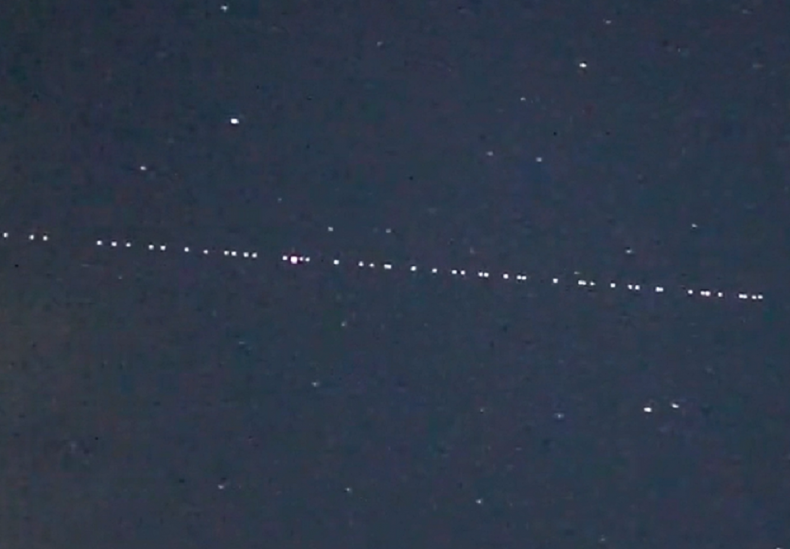Stunningly clear footage of a long line of satellites passing through space has been captured in Japan.
in a tweets on September 5, Daichi Fujii, a curator at the Hiratsuka City Museum in the city of Hiratsuka, Japan, posted a video of a pattern of what appeared to be dozens of white dots moving slowly across the sky.
The objects in question are a group of internet-beaming Starlink satellites built by US rocket company SpaceX. According to Fujii, that particular group of satellites had been launched earlier that day in what was SpaceX’s 40th mission of 2022 so far.

Daichi Fujii/@dfuji1/Twitter
Fujii told Newsweek he shot the video from his home in Hiratsuka with what he described as a high-sensitivity digital camera attached to a tripod. He then slowly moved the tripod by hand to follow the satellites’ movement.
Starlink Group 4-20)が見えました!2022年9月6日4時15分に平塚の自宅から撮影した様子です。11日にも打ち上げがあり、 ASTのBlueWalker 3は、スマホが直接通信するための直径10mのアンテナを搭載しています。明るく見えるかもしれません。 pic.twitter.com/iF6OYQVY82
— (@dfuji1) September 5, 2022
“It’s not the first time I’ve seen a Starlink satellite passing overhead,” Fujii said, translated from Japanese. “I’ve seen it many times before.”
Back in November, 2019, the museum curator posted another clear video of a trail of Starlink satellites passing overhead—that time with the camera staying in a fixed position.
2019年11月12日午後6時29分に平塚の湘南平から撮影したスターリンク衛星の様子です。平塚から1200km以上も離れたパスでしたが、高度7度の低い空を移動していく様子20時間経ち、少しばらけていました。 pic.twitter.com/BnuKMdSQjF
— (@dfuji1) November 12, 2019
It is a sight that has become increasing common over the years since SpaceX launched its first batch of Starlink satellites in May, 2019. At that time, 60 of the small satellites were placed into orbit in one go.
This might sound like a lot, but since then SpaceX has launched similar-sized swarms multiple times per month—sometimes multiple times per week.
Fifty-four of them were launched on August 28, followed by 46 on August 31 and the most recent batch of 51 on September 5.
Deployment of 51 Starlink satellites confirmed, completing SpaceX’s 40th mission so far this year!
— SpaceX (@SpaceX) September 5, 2022
As of September 8, 3,259 Starlink satellites had been launched in total according to the website of Harvard astronomer Jonathan McDowell. Due to some of them falling out of orbit since the start of the Starlink program, 2,991 of them are currently circling the Earth.
The purpose of Starlink is to provide a reliable and accessible satellite internet service to paying customers around the world—a technology that has traditionally been used mostly by people living in remote areas that don’t have access to other types of internet like cable or fiber .
Starlink’s strength is its low Earth orbit at an altitude of around 340 miles, meaning it takes relatively little time for data to transfer between its satellites and users on Earth. However, this means more satellites are needed to serve wider areas, hence Starlink’s vast constellation.
The vast number of Starlink satellites in orbit, some of which can be seen from the ground, has given rise to concerns that they could hinder clear views of the night sky for astronomers or casual observers.
SpaceX has taken steps to mitigate this, such as changing the materials on the outside of the satellites to reflect sunlight at different angles, and developing sun visors that help block sunlight from hitting the satellites in the first place.